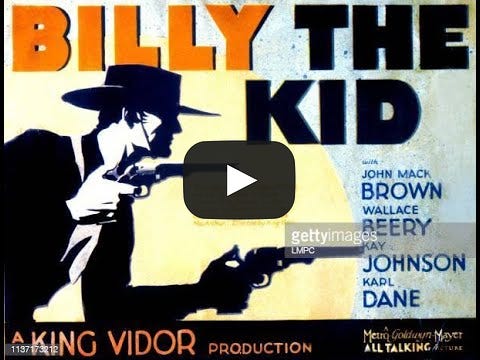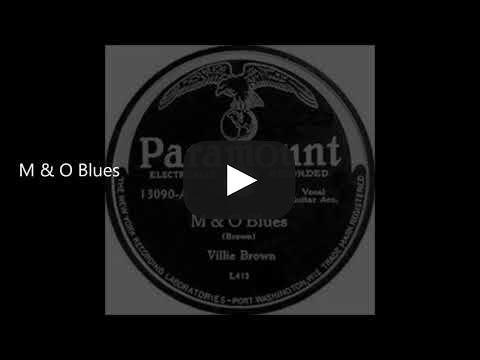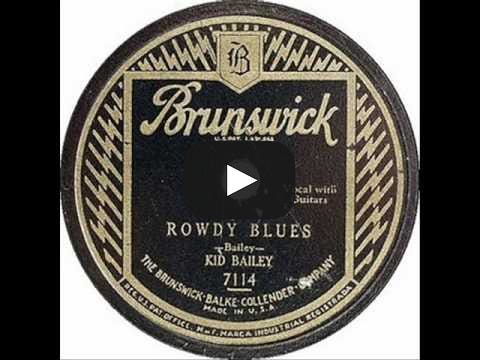Some people will tell you that Kid Bailey never existed. All we have is two songs—just 5 minutes and 49 seconds of music. And they were recorded 95 years ago. The tracks are riveting. But who is really singing on those tracks? And who is playing guitar? We’re not even sure if it’s the same person doing both. The only thing we know with certainty is the name on the record: Kid Bailey. But there’s never been a photo of Bailey—or autograph or birth certificate or ticket stub or anything. You can scour through every newspaper from that era, and you won’t find a single mention of blues musician Kid Bailey. If you want to support my work, take out a premium subscription (just $6 per month).Maybe that wouldn’t matter, except that the music is so bloody convincing. Bailey’s two surviving tracks rank among the finest blues performances of the decade—heartfelt, world-weary, brokenhearted. Just plain bluesy in the best sense of the term. His voice is lonesome and haunted, the way fans of the Delta blues like it. His guitar work is relaxed and confident, with none of the rhythmic uncertainty you often hear in other early country blues performers. But if you trust the information on the record sleeve, Kid Bailey strolled into the Peabody Hotel on September 25, 1929, where a visiting record label had booked a room and set up a makeshift studio. He recorded two songs, and then disappeared into oblivion. That’s all we know. Well, that’s not entirely true. Because at the start of his first song, Bailey wants to tell his life story. Unfortunately nobody can agree on what words he’s singing. According to the genius.com website, Bailey declares:
But Michael Taft, in his authoritative compilation of blues lyrics, offers the following transcription:
The former rendering makes more sense, but I absolutely don’t hear either version. Bailey is definitely not singing “believe” or “forever” or “reason.” Instead, what I hear is something like this:
 But all the transcriptions agree on one thing: Kid Bailey came from Mississippi, and didn’t plan to move elsewhere. There’s some irony here. That’s because later researchers—especially my friend the tireless blues detective Gayle Dean Wardlow—tried to find the missing Kid Bailey, and got hints and traces from many locales, as far afield as St. Louis. Back in the 1960s, Wardlow hoped that Kid Bailey might still be alive—and wanted to find him and bring him back to a recording studio. This might seem like a far-fetched dream, but other missing blues legends were re-emerging from obscurity during this same period. Son House got rediscovered after two decades—most people simply assumed he was dead. But suddenly he started recording and touring again. Skip James also returned after an absence of 33 years. Mississippi John Hurt showed up on stage after 35 years. So why not Kid Bailey? Wardlow had scanty evidence to work from. He heard that Bailey had perhaps gigged with Charley Patton in Skene, in the far west of Mississippi, or with Tommy Johnson farther south in Rankin County—but that would have been decades ago. Other sources told of Bailey performing in Leland or Tutwiler or Indianola. Henry Stuckey even claimed that Bailey had still been gigging as late as 1948—almost two decades after his record session—in Moorhead, Mississippi. If the latter account could be trusted, Bailey was playing mandolin at this point. My late friend Steve Calt (1946-2010), who was with Wardlow when Stuckey made this claim, told me it was a reliable testimony. Calt, I should add, was often highly skeptical of what informants told him. In a 2005 email, Calt shared these observations:
But this was still hearsay. And whenever Wardlow or Calt or others pursued these leads, they never got anything rock solid. Blues scholar David Evans added a disturbing detail in his 1982 book Big Road Blues:
Calt tried to get more details from blues legend Skip James, who merely admitted “I knew of Kid Bailey”—with emphasis on the word of. The implication was that Kid Bailey wasn’t the kind of person you would want to describe as a friend or even acquaintance. Consider the last lines of Kid Bailey’s “Mississippi Bottom Blues”—where he is defending himself against some vague accusation:
My conclusion from all this is that Kid Bailey broke the law, and served time. I’d encountered similar situations in my research for West Coast Jazz—some musicians (for example Dupree Bolton) disappeared completely, and their friends were reluctant to share details. But it’s because they went to prison. Under that scenario it makes sense that Bailey might show up in 1948—after his sentence was served—but without any fanfare or acclaim. He may have started playing blues again to make some money, but didn’t want to invite questions or excite curiosity. Before his death, Calt told me about another lead—never shared because it was too sketchy—about Kid Bailey’s involvement in a murder in St. Louis. According to Calt, a source suggested that Bailey
I left this detail out of my book Delta Blues, because Wardlow (who had been working with Calt when this story emerged) had no recollection of it. But maybe some other researcher can track down more details. Even without the St. Louis story, evidence for Kid Bailey’s criminal ties is significant. It’s worth noting that the nickname itself is suggestive of crime: “Kid” was frequently associated with lawbreakers back in the 1920s—used to refer to a thief, a punk, a hoodlum. Even today the term has gangsta associations in the hiphop world. Almost at the same moment that Kid Bailey made his recordings, Hollywood was filming the blockbuster movie Billy the Kid—another version of the same outlaw story they had been marketing since the early days of cinema. The similarity in nicknames seems deliberate: Billy the Kid and Kid Bailey.  Given all this evidence, I’m surprised that scholar David Evans eventually decided that Kid Bailey didn’t exist—a reversal of his earlier position. The strongest evidence for this comes from Son House, who allegedly listened to a Kid Bailey recording and decided it sounded like his friend Willie Brown. But Son House hadn’t heard Willie Brown in decades by that point. The rest of us can actually compare Willie Brown recordings with Kid Bailey’s surviving tracks and decide for ourselves. There’s a slight complexity here—because there’s also debate over who was the real Willie Brown. (At a future date, I’ll write an article on the four Willie Browns.) But if we follow the conventional accounts, the Willie Brown on “M&O Blues” should, if Evans is correct, sound like Kid Bailey.  But the singer of “M&O Blues” has a much rougher, grittier voice than the more honeyed vocalist on the Kid Bailey tracks.  Evans’s other argument is that someone as skilled as Kid Bailey would be much better known if he had really existed—hence a pseudonym is more likely. But the criminal hypothesis described above is sufficient to explain why (1) Kid Bailey disappeared, and (2) People were reluctant to talk about him, or referred to him in guarded, derisive ways. When I asked Wardlow about Evans’s theory, he was vehement in denying it. He responded:
I admire both Wardlow and Evans, but I must point out that they fiercely disagree on many matters. The field of blues scholarship is filled with rivalries—LaVere versus McCormick, Hamilton versus McKune, etc. But Evans versus Wardlow is one of the heavyweight matchups. I suspect each one takes pleasure in debunking the other. Evans, however, has a huge advantage. He’s a Harvard-trained full professor who, more than anyone, legitimized blues scholarship as an academic discipline. Wardlow, in contrast, created his own credentials, and did it through persistence, passion, and hard work. He lacks Evans’s glittering CV—but nobody I’ve met in my entire life bled and suffered more for the Delta blues than Gayle Dean Wardlow. My favorite story about Wardlow tells of him taking a job as a pest exterminator in impoverished Mississippi neighborhoods—so he had an excuse to visit homes and ask (while doing his job) if they owned any old blues 78s. They don’t teach that kind of dedication at Harvard. But maybe they should. I also admire Evans, who has made super-sized contributions to the blues, but you can’t simply assume that the Ivy League-trained professor must be right, not the amateur blues enthusiast. In the case of Kid Bailey, I fear that Evans’s speculations are now erasing him from blues scholarship. Some reissues actually refer to Kid Bailey as “Willie Brown”—case closed. That’s because, if Prof. Evans says it’s so, it must be so. But the case is not closed. Evans has his theory, but I don’t find it especially persuasive. (However, I might accept that Bailey did the singing at his session while Willie Brown played guitar—this is more plausible, based on what I hear on the tracks.) In any event, the accumulated evidence is clearly insufficient to erase Kid Bailey from the blues history books. Wardlow, for his part, never found the flesh-and-blood Kid Bailey. But we have good reason to believe that he was on the trail of an actual person. Yes, Mr. Bailey was a mysterious figure—somebody others didn’t want to talk about. Maybe even a killer. But a person nonetheless. We may never have any more than this, but it’s something: Almost a hundred years ago, a man at the Peabody Hotel in Memphis left behind an unsolved mystery—and 5 minutes and 49 seconds of astonishing music. Maybe that should be enough for us. You're currently a free subscriber to The Honest Broker. For the full experience, upgrade your subscription. |
Search thousands of free JavaScript snippets that you can quickly copy and paste into your web pages. Get free JavaScript tutorials, references, code, menus, calendars, popup windows, games, and much more.
Who Was Kid Bailey?
Subscribe to:
Post Comments (Atom)
Top 3 UX Design Articles of 2024 to Remember
Based on most subscriptions ͏ ͏ ͏ ͏ ͏ ͏ ͏ ͏ ͏ ͏ ͏ ͏ ͏ ͏ ͏ ͏ ...
-
code.gs // 1. Enter sheet name where data is to be written below var SHEET_NAME = "Sheet1" ; // 2. Run > setup // // 3....

No comments:
Post a Comment